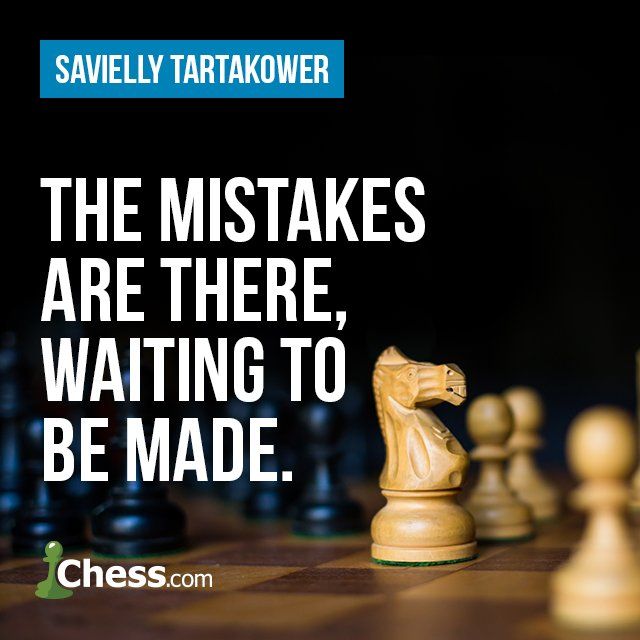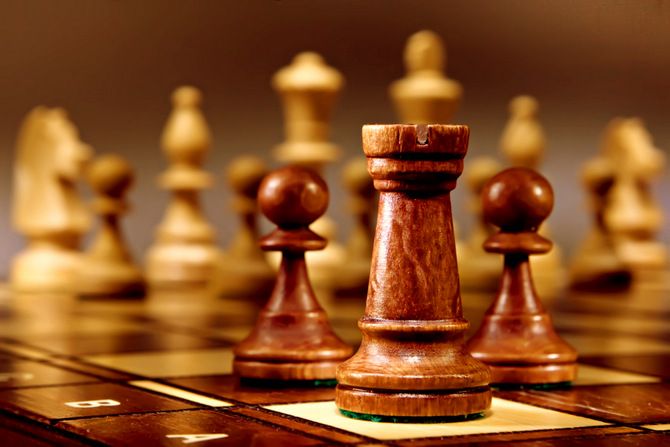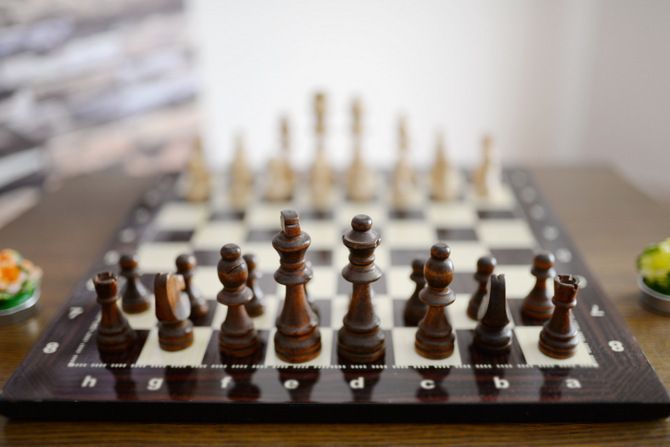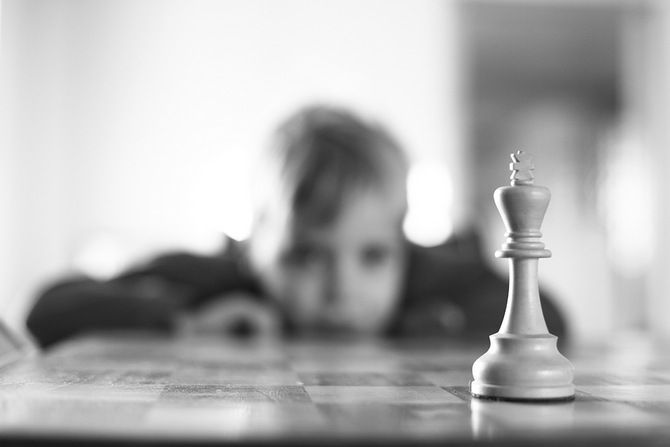
The 10 most common chess mistakes among beginners
There is one thing chess players at all levels have in common: we want to play better. From the player who just learnt how to move the pieces all the way to Magnus Carlsen. And the good news is that there is always room for improvement. ![]()
But it takes work, because mistakes are always there, hovering over the hand that makes the moves, waiting to be made.

Beginners often think that the difference between a modest amateur and a strong master is the number of mistakes they make. However, the real difference is not in the number of mistakes, but in the kind of mistakes that are made. While beginners will watch as their opponent captures all their pieces move by move, the kind of mistake that an experienced player makes will more likely be related to creating a weak square or pawn, to name a few examples.
So, we could say that a chess beginner's mistakes are more serious, but in this article we will see what are the most typical mistakes, the ones that we must avoid.
Mistakes in the opening
An amateur looking to improve his game must know that in the first phase of the game certain rules must be followed:
- To control (and if possible, to occupy with one's pawns) the center of the board
- To develop minor pieces (bishops and knights) as soon as possible
- To castle early in the game, to keep the king safe
The most common mistakes in this phase of the game are precisely those that breach these basic rules.
Mistake #1: Playing too many moves with pawns.
In the opening you should play few moves with the pawns, and they should be aimed to controlling and occupying the center of the board (just like in soccer, it is important to control the midfield, in chess the center of the board is fundamental). But many amateurs make the mistake of making too many moves with their pawns, which delays the development of bishops and knights. Also, the king remains exposed in the center for too long. The famous Légal Trap is a good example in which the lack of development of the opponent caused by too many moves with pawns is punished.
Mistake #2: Developing the queen too early
When we learn the rules of chess, we find out that there is a specially powerful piece: the queen. This may lead us to try to get the most out of it from the very beginning. However, as we said, it is much better to develop knights and bishops first. Moving the queen too early and trying to create threats with it can put it under the attack of enemy pieces. In many cases what can happen is that our opponent will put in play pieces that attack our queen so that while they are developing, we are forced to move around the queen to avoid its capture.
Mistake #3: Keeping the king in the center
The king's safety is obviously a top priority in a game of chess. We often postpone the castling because we can see no imminent threat, but it is very advisable, especially in the first learning stages, to be firm with this rule: castle as soon as possible. The risks of keeping the king in the center are shown in the following example.
Mistakes in the middlegame
If we follow the fundamental laws of the opening (occupying the center, developing minor pieces and castling as soon as possible), we will be able to reach the middlegame with an optimal position. But in this phase of the game there are also some typical mistakes that we must avoid. Here are the most frequent.
Mistake #4: Keeping pieces undefended
There is a chess term that you should become familiar with: piece coordination. This means that our pieces must occupy good squares (where they're active) and preferably where they can take joint actions. It is not good for several of our pieces to be undefended, since our opponent could take advantage through tactical resources (normally a double threat). Thus, ideally our pieces should defend each other. We know this is not always possible, but we must pay attention to try not to leave too many pieces undefended. In these three examples, White can take tactical advantage of the opponent's undefended pieces. Would you know how to do that?
Mistake #5: Not putting the rooks into play
Just like in the opening we must try to develop our knights and bishops, in the middlegame our major pieces (queen and rooks) must come into play. It's usually important to clear our first rank in order to connect the rooks (that is, to look for a good square for the queen so that the rooks are coordinated.)
But the rooks must play a main role in the middlegame and, for that, we must place them in the best squares. Ideally, they should be in open or semi-open files. An open file is that in which there are no pawns from either side. A semi-open file is that in which we have no pawns but our opponent does. And so, as the game moves forward and pawns are traded, some files are emptied and we must try to use them to activate our rooks.

A very frequent mistake is leaving one of the rooks in their original square and forgetting a piece that consequently cannot participate in the game.
If there are no open files, in some cases we can place our rooks in the central files, behind our most advanced pawns.
Mistake #6: Weakening the castling
During the opening, we castle in order to put our King to safety, but during the middlegame we must keep our castling protected. For this, it is important not to advance the pawns that protect the King. Their mission is to keep it safe and, when they move, they leave the King unprotected.
We will also try not to double pawns in the castling, so be careful with trading in that area of the board.
For a castling to be safe we must keep the defending pieces near, especially if the opponent can bring his pieces close to initiate an attack.
Mistake #7: Playing without a plan
It is said that it's better to play following a bad plan than with no plan at all. And it does make some sense. One of the most frequent mistakes made by the beginner is moving for the sake of it. Each move must have an idea behind it!

In the middlegame it is key to have a general idea of what we want to do. It's not enough to make a move just because it's our turn. It must make sense and, if possible, it must follow a general idea. Of course, this will be easier to achieve once we become more experienced and familiar with certain patterns that can help us.
That is why the chess aficionado must get used to analyzing the positions and learning the main weaknesses (which affect the King, as we mentioned in the previous section, but also weak squares and pawns, which we will address soon in a new article).
Two tips for those positions in which we don't know what to do:
1. Improve our own pieces
2. Figure out our opponent's plan, or think how he could improve his position and try to avoid it.
Mistakes in the endgame
Mistake #8: Not activating the King
We make such a big deal of the King finding shelter in the castling during the opening and for it to stay protected during the middlegame that beginners often forget that in the endgame the King must play an active role.
Once there are fewer pieces left on the board, there are fewer chances of attacking the enemy King, so it can be activated. It's a piece like any other that can make threats and play a main role.

In fact, there are cases in which one of the players is incapable of activating their King and the situation is similar to being down a piece. I was very impressed some time ago with this example in which Black was forced by the opponent to end up with a totally inactive King, which finally transformed into a win for White.
Mistake #9: Not paying attention to the creation of passed pawns
Passed pawns are undoubtedly the great protagonists of most endgames. When we learn each piece's value we are told that a pawn is worth one point... and that is forged in our minds! Well, remember that as there are fewer pieces left, the pawns' value gradually increases and more so if they become passed pawns (that's how they call the pawns that can't be stopped or blocked by other pawns on their way to promoting).
The key in many endgames is how to create passed pawns. Here are a couple of examples:
Mistake #10: Making mistakes in simple theoretical endgames
You shouldn't think that in order to improve your chess it's enough to practice. It's very convenient to study a little bit and, in the endgame, it's very helpful to know some theoretical positions.
Apart from the basic mates (queen vs king, rook vs king, two bishops vs king), you should learn some basic concepts, such as opposition in pawn endgames and the subtleties behind the "rook pawn and bishop vs king" endgame or the "queen vs pawn on 7th rank" endgame.
Many players insist on studying only the openings because they think that endgames are either boring or hard. We encourage you to study endgames. You will be surprised by how interesting they can be.
And, since this is my first article for Chess.com, please leave a comment suggesting topics for future articles.

